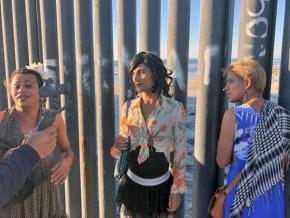What the caravan is facing in Tijuana
In this report first published by the New Mexico-based Red Nation, describes the conditions facing members of the refugee caravan who have reached the city across the border from San Diego.
THE CARAVANS arriving in Tijuana should be seen as a collective and organized response to the political crisis in Central America — in this case, Honduras.
Since 2011, the homicide rate in Honduras has been between 50 and 90 people per 100,000 residents. These rates are about the same rate as it was during the civil war there in the 1980s. By comparison, in the United States, it is about 5 people per 100,000 killed.
It has become impossible for children to attend public school. Now the Honduran government is sealing the border every three days or so.
The United States used Honduras as a military base during the civil war years in Central America, begun under Jimmy Carter and continued under Ronald Reagan, from which the U.S. military intervened in Nicaragua, Guatemala and El Salvador.

Now the civil war is between gangs — Mara Salvatrucha and Barrio 18, both deported from California’s criminal justice system in the 1990s — and the government. In neighboring El Salvador, the UN Special Rapporteur on extrajudicial killings, Agnes Callamard, reported that the government has carried out about 450 extrajudicial killings of young people (suspected gang members) this year, and I’m sure that the statistics are similar in Honduras.
In 2009, the Obama administration, led by Secretary of State Hillary Clinton, carried out a coup in Honduras. Still, according to Honduras Solidarity Network, many Hondurans stayed in the country to fight for democracy and liberation. The turning point for many came in 2017 when Juan Orlando Hernández stole a contested election, and was backed by the Trump administration. Many, many people decided that it was time to go.
The Caravans
Caravans are a way of finding safety in numbers on the long trek north through cartel territory, and they are a way to avoid paying coyote fees. But they are also a collective political response to a crisis; this caravan coming up from Honduras is conscious of raising demands of the U.S. empire.
They use a decision-making process that wavers between consensus and democratic centralism. They have been accompanied by U.S. activists along the way from groups like Pueblo Sin Fronteras and Texas-based Raices. These activists provide material support and also affect the political character of decision-making bodies, for better or for worse.
Not to say that they express the highest form of political consciousness. I was with the LGBT+ contingent in Tijuana. They had left the larger “exodus” (another word that the caravan uses) because they faced intense harassment from other caravan members. Under the intense pressures of the situation, solidarity can break down — even among and between the smaller contingent of LGBT people.
The trans women will almost certainly qualify for asylum (if they get legal representation, like with the group that asked me to go down to Tijuana and help with legal observing). There are children with the contingent that I was with. It was heartbreaking to play with the children and have their parents ask me whether their kids would be taken away. Because there is no certain answer to that, especially if Trump puts the “binary option” into play.
The Mexican government has started to threaten those who accompany the caravan (particularly the trans women) with sex trafficking. Some of my time in Tijuana was spent making sure that the Mexican department of sex trafficking and child welfare services did not intervene with the contingent without warrants and due process.
I believe it was for this reason that I was held in secondary inspections coming back across the U.S. border for a while (I know that the authorities looked at my license plate when I ran an errand). They took and read my cell phone and journal, and made me sit for just under two hours because I would not answer their questions about the whereabouts of the asylum seekers and what their plans were.
I believe that the Mexican and U.S. governments are collaborating about ways to crack down on solidarity activists.
The Crisis
Meanwhile, there is a humanitarian crisis in Tijuana because Trump is breaking the law (both the 1965 US Immigration and Naturalization Act and the 1967 United Nations Protocol Relating to the Status of Refugees). Under both U.S. and international law, asylum seekers can present themselves and explain their fear of violence, and receive an asylum hearing.
The two illegal things that Trump is doing is only letting 50 people per day cross through the port of entry to ask for asylum (when at least 5,000 have arrived in Tijuana, and there are more coming). Secondly, he has said that if you enter outside a port of entry (or “cross illegally”), you will be deported immediately and not considered for asylum — a clear violation of U.S. law. But until it is challenged in court, it is the operating principle that the U.S. government is using.
All the reports of solidarity in Mexico are true. It is also true that right-wing Mexicans have been attacking and mobilizing against the caravanistas. There is intense pressure on the city’s infrastructure. San Diego-based cross-border justice groups are calling for a national day of action. I also know a group of antiwar veterans in the U.S. who are trying to organize a contingent to the border to oppose the use of troops to militarize the border.
Here in New Mexico, we have the opportunity to organize against the detention of some of these people, especially the trans women, at the Cibola Detention Center (run by the private prison CoreCivic), and also to support them as they get out.
First published at The Red Nation.


